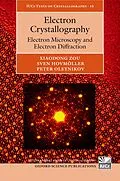In the modern world of ever smaller devices and nanotechnology, electron crystallography emerges as the most important method capable of determining the structure of minute objects down to the size of individual atoms. Crystals of only a few millionths of a millimetre are studied. This is the first textbook explaining how this is done. Great attention is given to symmetry in crystals and how it manifests itself in electron microscopy and electron diffraction, and how this symmetry can be determined and taken advantage of in achieving improved electron microscopy images and solving crystal structures from electron diffraction patterns. Theory and practice are combined; experimental images, diffraction patterns, formulae and numerical data are discussed in parallel, giving the reader a complete understanding of what goes on inside the "black boxes" of computer programs. This up-to-date textbook contains the newest techniques in electron crystallography, including detailed descriptions and explanations of the recent remarkable successes in determining the very complex structures of zeolites and intermetallics. The controversial issue of whether there is phase information present in electron micrsocopy images or not is also resolved once and for all. The extensive appendices include computer labs which have been used at various courses at Stockholm University and international schools in electron crystallography, with applications to the textbook. Students can download image processing programs and follow these lab instructions to get a hands-on experience of electron crystallography.
Autorentext
Xiaodong Zou is the chair of Inorganic and Structural Chemistry Unit, Department of Materials and Environmental Chemistry, and director of the Berzelii Centre EXSELENT on Porous Materials, Stockholm University. She is a member of the IUCr Commission on Electron Crystallography (2002-2011) and the Structure Commission of International Zeolite Association (2010-). She received several awards, including the K.H. Kuo Award for Distinguished Scientist (2010) and, Göran Gustafsson Prize in Chemistry (2008) and Tage Erlander Prize (2002), both given by the Royal Swedish Academy of Sciences. Her main research interests include method development for 3D structure determination of nano-sized materials by X-ray diffraction and electron crystallography, especially on zeolites and related porous materials and complex intermetallic compounds, and synthesis and applications of inorganic open-framework materials and metal-organic frameworks. Peter Oleynikov has been a researcher at Stockholm University since 2008. He writes programs for computer control of electron microscopes and for analysis of the diffraction data obtain, as well as programs simulating EM images and electron diffraction patterns. Sven Hovmöller was visiting scientist in Madrid and Nantes and was Secretary of the IUCr commission on Electron Crystallography 1999-2002. He introduced image processing of EM images by Fourier transform analysis from molecular biology into inorganic chemistry in 1984 and started, together with Xiaodong Zou, the series of annual International schools in Electron Crystallography, in 1994. Hovmöller develops new methods and computer programs for electron crystallography and is also interested in quasicrystals and their approximants and protein structure and its prediction.
Inhalt
- Preface
- 1: Electron crystallography - an introduction
- I. Fundamental crystallography
- 2: Fundamental crystallography
- 3: The effects of symmetry in real and reciprocal space
- II. Fundamental electron microscopy
- 4: Fundamental electron microscopy
- 5: Electrons interact strongly with matter
- 6: Electron diffraction
- 7: Phase identification and 3D electron diffraction
- 8: Phase contrast, contrast transfer function (CTF) and high resolution electron microscopy (HRTEM)
- 9: Convergent beam electron diffraction
- 10: Simulation of Images and electron diffraction patterns
- III. Structure determination by electron crystallography
- 11: Solving crystal structures from HRTEM images by crystallographic image processing
- 12: Experimental procedures for Crystallographic Image Processing
- 13: Solving crystal structures from ED data
- 14: Structure refinement from ED data
- 15: 3D electron crystallography
- 16: Applications
- IV. Appendices
- Appendix 1: Goals of a course in electron crystallography
- Appendix 2: Sample preparation
- Appendix 3: Reflection conditions generated by symmetry elements and lattice
- Appendix 4: Characteristics of the 17 plane groups and 3D Space group determination
- Appendix 5: Convolutions, Fourier transforms and how to get phases - an introduction
- Appendix 6: Identify HRTEM images, Calculated FT from HRTEM images, SAED patterns and potential maps
- Appendix 7: Computer lab on crystallographic image processing of HRTEM images
- Appendix 8: Indexing electron diffraction patterns
- Appendix 9: Computer lab on quantifying and analysing electron diffraction patterns
- Appendix 10. Determining space group and unit cell dimensions from ED patterns- Web page/ Server- Computer labs, including processing HRTEM images and ED patterns, Original Datasets, Figures, Images and ED patterns - related to the examples described in the book, The programs CRISP, ELD and Space Group Explorer
